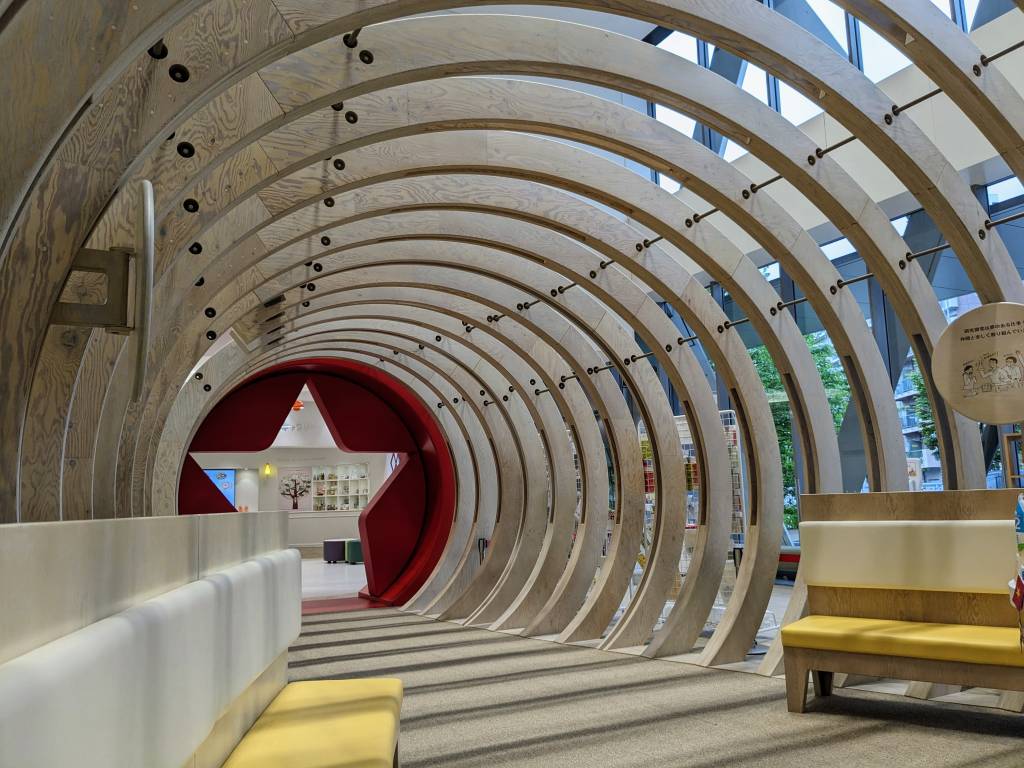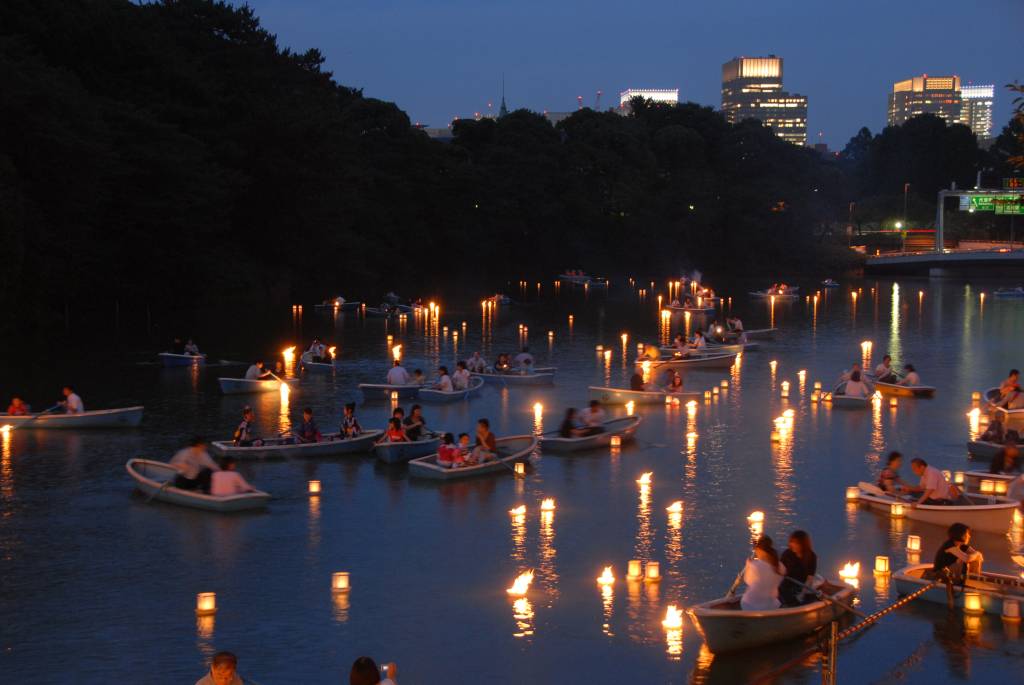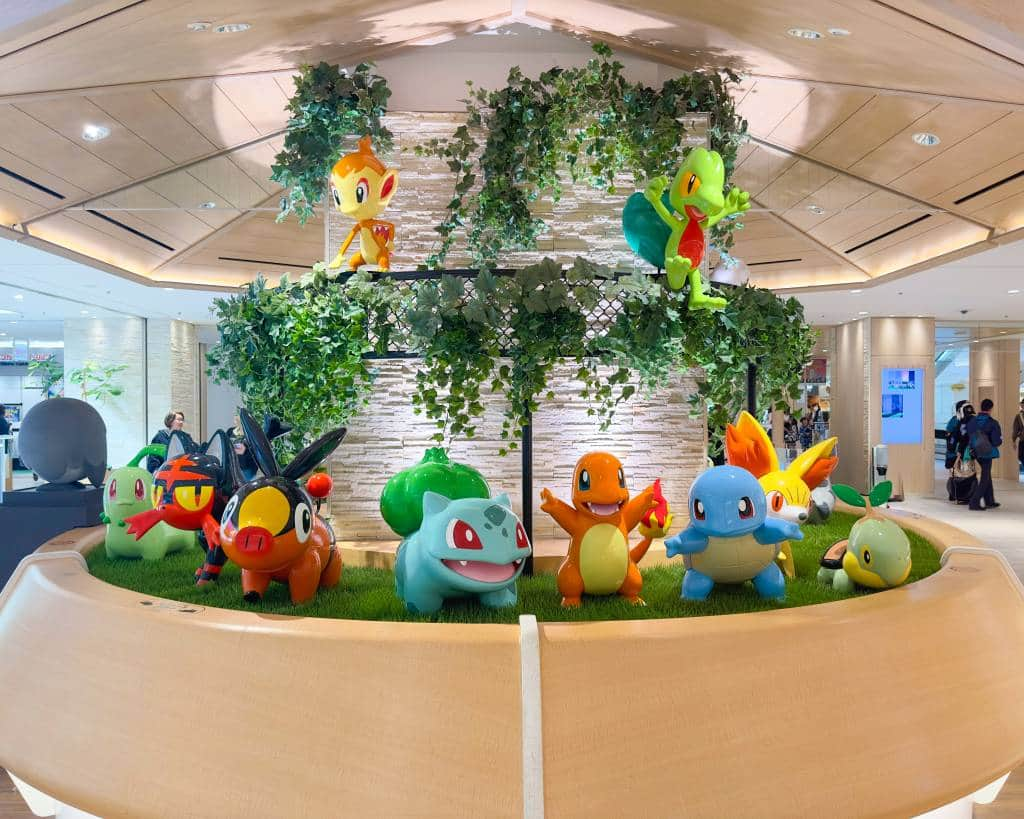Despite summer events like Fuji Rock and Summer Sonic getting most of the spotlight, dripping in sweat and torrential rain isn’t a prerequisite to attending a music festival in Japan. If milder weather is more your speed, fall brings with it a ton of outdoor music events showcasing some of the best artists from Japan and around the world.
To help you celebrate the cooling temperatures and the reddening leaves, we’ve gathered some of our favorite music festivals coming up this autumn, from bayside rock and hip-hop festivals to multi-genre, multi-day camping events in a variety of tranquil mountain locales. So ditch your portable fans and rain boots and see what the new season has in store for you, with our guide to autumn music festivals in Japan.
1. Camping festivals
With temperatures dropping and sunlight becoming just a bit more bearable, autumn is arguably the best time of year to head out into the great outdoors for a music festival in Japan. Here’s some of our top picks for events offering autumnal forests, flowing rivers and even Mt. Fuji views.
Note: We’ve included transport information from Tokyo. If you are planning to drive, check out our guide to renting a car in Japan.
Matricaria
September 21–23, 2024¥6,000–¥17,000
Iwaki no Sato Onigajo, Iwaki, Fukushima Prefecture
Techno, house, and disco in the Fukushima mountains
One for nature lovers is the relatively new grassroots event, Matricaria. Making its debut at Hirayama in Yamanashi Prefecture in 2022, the event then moved to Fukushima.
The festival continues at Fukushima’s Iwaki no Sato Onigajo this year, with a techno-, house-, and disco-oriented line-up across three stages in the Abukama Highlands. This year’s lineup features artists such as British Producer Mark Broom, house and disco DJ YAMARCHY, and hip hop DJ Mitsu the Beats. It offers a range of accommodation options, including camping, bungalows, and nearby hotels and Japanese-style inns.
Getting there
The Matricaria website recommends driving yourself or jumping aboard the festival’s bus tour. For those planning to drive from central Tokyo, it’s around 2 hours on the Joban Expressway to the Iwaki-Chuo Interchange. From there, it’s an hour or so to Iwaki no Sato Onigajo.
At the time of writing, bus tour information hadn’t been made available, but keep an eye on the festival website for more info. For those planning to come by train, the festival grounds are a roughly 20-minute cab ride from Natsui Station or Kawamae Station on the Ban-Etsu East Line. Organizers recommend booking a cab in advance.
Asagiri Jam
October 12–13, 2024¥5,000–¥25,000
Asagiri Arena, Fumotoppara, Fujinomiya, Shizuoka Prefecture
Mt. Fuji views and wholesome relaxation

The little brother of Fuji Rock Festival, Asagiri Jam takes place near the base of Mt. Fuji. The festival has happened almost every year since 2001, and has earned a reputation for its laidback, family-friendly, and pet-friendly vibes.
Featuring two stages, the event typically hosts a combination of up-and-coming and established local and international artists playing hip-hop, indie, and chilled electro tunes. The 2024 line-up features Canadian artist Caribou, Never Young Beach’s Abe Yuma, Charlotte Day Wilson, and Tokyo psych-rockers Hitsuji Bungaku. Various parking, camping, and accommodation packages are available via the festival’s website.
Getting there
The Fumotoppara campground is around a 2-hour drive from central Tokyo. Take the Kawaguchiko Interchange from the Chuo Expressway to Route 139, then continue on for around 30 km.
Those coming by train can get the Shinkansen to Shin-Fuji Station or the JR Tōkaidō line to Fuji Station. Shuttle buses are available from each of these stations to the festival site, but you’ll need to book tickets in advance.
Gaia
October 12–14¥15,000–¥21,000
Kyoto Rurikei Onsen for Rest Resort, Kyōtango, Kyoto Prefecture
Health and wellness set to psych, trance, and techno
Music and nature lovers will be heading to Kyoto this autumn for the Gaia festival. Based on the concept of “love and gratitude to the universe”, Gaia is considered the largest psychedelic festival in Japan, regularly featuring a strong line-up of psychedelic, trance, and techno artists. This year’s line-up sees Tokyo’s Yurufuwa Gang making one of many fall festival appearances, as well as France’s Okapi, and England’s Sonic Species.
The event centers on health and wellness, with this year’s plans featuring yoga, reiki, and health workshops, as well as a kids’ area, live painting, and, you guessed it, onsen areas. Held over three days, the festival offers various camping and accommodation options, with some already starting to fill up.
Getting there
For those coming from the Kansai area, the festival grounds are approximately a 1-hour drive from Osaka or Kyoto. Those coming from Tokyo can expect to drive 6 hours or so. The main parking lot is limited to 300 vehicles.
If you’d rather take the Shinkansen, it’ll take around 2 hours from Tokyo Station to Kyoto Station on the Tōkaidō-Sanyo Shinkansen. From there, get a limited express on the Hashidate Line or a rapid train on the San-in line to Sonobe Station. There are regular shuttles running to and from Sonobe Station and the festival grounds that take around 30 minutes each way.
M Festival
October 19–20¥7,000–¥13,000
Canyons, Minakami, Gunma Prefecture
Eclectic music and laidback vibes in the mountains
M Festival is back at Minakami this year for its third installation at its new home. Initially kicking off in 2020 in Myōkō, the new riverside location, set in the mountains of Gunma, continues the producers’ philosophy of hosting a world-class and inclusive music festival in the hills of Japan.
This year’s event showcases Japanese soul and garage rock artists such as Toshimi Watanabe and Minnesota Voodoo Men, as well as Tokyo-based DJ collective Caribbean Dandy. A variety of accommodation is available near the festival grounds, including mountain lodges and hotels, as well as camping and glamping sites.
Getting there
From central Tokyo, it’s a roughly 2.5-hour drive on the Kanetsu Expressway to the Minakami Interchange in Gunma Prefecture. From there, The venue is a 15-minute drive, and the site has free parking. For those taking the train, the closest stations are JR Minkakmi and JR Yubiso stations. The closest Shinkansen station is Jomo-Kogen Station.
2. Bayside Festivals — Tokyo
With Odaiba playing host to some huge festivals this season, you don’t need to head too far to soak up some great music and bayside breezes. Whether you’re planning to stay out all night or get home in time for tea, these parties have something for everyone.
Ultra Japan
September 14–15¥10,000–¥46,000
Odaiba Ultra Park, Aomi
Tokyo’s biggest electronic music festival
International electronic producers Ultra will present the ninth installment of Ultra Japan in 2024. Having tested the waters with Road to Ultra, a single-day, single-stage event in 2012, Ultra Japan exploded onto the annual festival calendar in 2014 with a massive line-up including headliners like Afrojack, Martin Garrix, and Steve Angello — and hasn’t slowed down since.
Returning to its home at Odaiba Ultra Park this year, the event will take place over two days and three stages with headliners including Afrojack, Alesso, Armin Van Buuren, Isoknock, and Steve Aoki.

Getting there
What the organizers refer to as Odaiba Ultra Park is an area outside the Diver City shopping center. If you’re coming by public transport, it’s a short walk from Daiba, Tokyo International Cruise Terminal, or Aomi stations on the Yurikamome Line or Tokyo-Teleport Station on the Rinkai Line.
agefarre 2024 — ageHa×velfarre vol.13
September 29¥5,500–¥12,000
City Circuit Tokyo Bay, Aomi
A big taste of Tokyo club culture
Two names synonymous with Tokyo club culture, ageHa and Velfarre, are back at Odaiba this September with volume 13 of their collaborative event, agefarre. Helping to launch the Para Para scene from the mid-90s, Roppongi-based venue Velfarre has maintained its reputation among Tokyo partygoers even since closing its doors in 2007. Similarly, despite its home base at Shin-kiba’s Usen Studio Coast shutting down in 2022, ageHa has continued to prosper as one of Tokyo’s most lauded taste-maker party planners.
The 13th iteration of agefarre will be held at Odaiba’s City Circuit Tokyo Bay with an extensive lineup of DJs, VJs, performers, and producers including DJ YOJI BIOMEHANIKA, John Robinson, DJ Dragon, Remo-con, and many more.
Getting there
City Circuit Tokyo Bay is a go-kart track near Aomi Station on the Yurikamome Line. Those coming on the Rinkai Line can hop off at Tokyo-Teleport Station and walk around 2 minutes to the venue.
The Hope
September 21–22¥13,000–¥44,000
“Odaiba the Hope Special Venue,” Aomi
The biggest names in Japanese hip-hop
Japan’s largest hip-hop festival is set to break its own attendance record with another line-up of heavy hitters this September. First held in 2022 at Yoyogi First Gymnasium with an ambitious list of over 50 artists, The Hope has quickly expanded in its short tenure. This year, it will further expand its scale to more than 70 artists over two days, anticipating an audience of over 30,000.
Joining big names like Creepy Nuts, Awich, Yurufuwa Gang and JP The Wavy is Lana, whose recent singles have dominated Japanese hip-hop playlists, and a huge line-up of DJs from across the country.
Getting there
Although the festival website doesn’t list a specific location for the event, it does say that it’s in Aomi-1-chōme, near Diver City. If you’re coming by public transport, the website recommends walking 5 minutes from Daiba Station if coming on the Yurikamome Line, or 3 minutes from Exit B of Tokyo Teleport Station on the Rinkai Line.
Blue Note Jazz Festival
September 21–22¥15,000–¥70,000
Ariake Arena, Ariake
Making its triumphant return

Autumn 2024 will mark the return of Blue Note Jazz Festival Japan for the first time in eight years. Originally held in New York by legendary jazz venue Blue Note, the festival expanded to Japan in 2015. It followed its success in 2016 with a diverse line-up of artists, including Earth Wind and Fire, George Benson, and Andra Day.
This year, the event will move from its previous home at Yokohama Red Brick Warehouse to Ariake Arena in Tokyo as a two-day event with a substantial bill spanning multiple generations and genres. The opening day will see groundbreaking hip-hop artist NAS, funk-soul legends Parliament Funkadelic with George Clinton, and Louisiana’s Tank and the Bangas. The second day doesn’t let up, featuring pop-rock giants Chicago, Marcus Miller, Nile Rodgers and Chic, Snarky Puppy, and more to be announced in the coming weeks.
Getting there
The Blue Note Jazz Festival website recommends coming by public transport. For those coming on the Yurikamome Line, Ariake Arena is a roughly 8-minute walk from both Shin-Toyosu Station and Ariake-Tennis-no-mori Station. On the Rinkai Line, the venue is around 17 minutes on foot from Shinonome Station and Kokusai-Tenjijo Station.
3. Bayside festivals — Aichi and Shizuoka
Escape the city and head to the coast for a change of scenery. Ever been to a hip-hop festival at an airport? What about a heavy metal festival on a beach? Maybe this is your year.
Treasure05x
September 7–8¥8,800–¥17,600
Laguna Beach, Gamagori, Aichi Prefecture
Beachside heavy rock
Self-described as “The Most Emotional Rock Festival in AICHI, JAPAN!,” the Treasure05x (Treasure Zero Go x) festival has been a go-to for heavy music since 2004. Commonly referred to as Treasure, it’s developed a loyal following of rock fans, drawing large crowds each year.
This year, the event returns to Laguna Beach in Gamagori, Nagoya, with artists performing on two stages across two days. Saturday’s headliners include The Oral Cigarettes and Kana Boon, with Alexandros and Ellegarden headlining on Sunday. If you want to get involved before the main event, the festival also promotes a series of gigs at local music venues from August 10-20.
Getting there
The quickest way to get to the festival grounds from Tokyo is via the Shinkansen to Toyohashi Station. From there, it’s a local train to Mikawa-Ōtsuka Station and then a 9-minute bus ride or 20-minute walk. Anticipate around 2.5 hours total from Shinjuku Station.
FFKT Izu Shirahama
September 28–29¥10,000–¥18,000
Izu Shirahama Hotel Izukyu, Shimoda, Shizuoka Prefecture
Indie, hip-hop, and electronic tunes by the sea

From the dense forests of Nagano to the coastal waters of Izu, the team behind the popular festivals Taicoclub and FFKT brings you the beachside FFKT Izu Shirahama. Returning for its second run at Hotel Izukyu in Shirahama, Shimoda, on the Izu Peninsula, this year’s event promises another diverse collection of international artists from indie, electronic, and hip-hop circles.
The event spans two days and multiple indoor and oceanside stages. The current line-up includes New York electronic artist Anthony Naples, Kyoto- and Harlem-based dance artist Chanaz, and Tokyo three-piece CHO CO PA CO CHO CO QUIN QUIN, with more artists to be announced. At the time of writing, one-night accommodation plans were available at Hotel Izukyu.
Getting there
Driving from central Tokyo can take anywhere from 3–5 hours, depending on traffic. If you’re taking the train from Tokyo, the picturesque Odoriko Limited Express departs from Shibuya Station and takes less than 3 hours to get to Izukyū-Shimoda station. From there, it’s a 10-minute bus ride to the festival grounds.
Wired Music Festival
October 13¥12,000
Aichi Sky Expo, Centrair, Tokoname, Aichi Prefecture
Art, fashion, food, and hip-hop
Wired Music Festival is a newer addition to Japan’s international festival calendar. Also in Aichi, the event is held outdoors at Aichi Sky Expo, an exhibition hall on an artificial island in Ise Bay. Launched in 2015, the festival showcases art, fashion, and food in addition to local and international hip-hop and R&B artists.
This year’s line-up will feature NLE Choppa, Okinawa’s Awich, and Number_1, who recently performed at Coachella. The official website includes detailed information in English, but if you’re interested in attending, jump on tickets soon because they’re already selling quickly. The event finishes at 9 p.m., which means those based in Tokyo can still catch public transport home, which takes around 2.5 hours.
Getting there
For those coming from Tokyo, the festival website recommends coming via the Shinkansen from Tokyo Station to Nagoya Station. Head to Meitetsu Nagoya Station and take the Meitetsu Tokoname Line to the Meitetsu Central Japan International Airport Station. From there, it’s a 5-minute walk to the festival venue at Aichi Sky Expo.
4. Inner-City Tokyo
If you’re after somthing a little closer to the city, this festival in Shinjuku’s Kabukichō has you covered.
Mind Travel Tokyu Kabukichō Tower Edition
October 26¥7,500–¥9,000
Tokyu Kabukichō Tower, Kabukichō, Shinjuku
Sauna, shisha, CBD, and careful curation

Mind Travel is a rare festival that offers the kind of meticulous artist curation that you can only get from some of Japan’s biggest music nerds. Produced by the team behind music media company Spincoaster, the festival first kicked off in Myōkō in 2021 and has just announced its sixth iteration.
The event will take over Shinjuku’s Tokyu Kabukichō Tower and aims to “balance the mind and body” with a combination of live music and a chill-out area replete with tent saunas, shisha, and original CBD products. The line-up this year covers a mix of artists you either do know or should know, like Shinichi Osawa (Mondo Grosso), Okinawa’s newcomers HOME, Korean indie quartet ADOY, and R&B artist VivaOla. Heaps more artists and DJs are set to be announced, and early-bird tickets are already on sale.
Getting there
Tokyo Kabukicho Tower is a 7–8-minute walk from Shinjuku or Shinjuku Sanchōme stations, and a 1-minute walk from Seibu-Shinjuku Station.

Autumn music festival FAQs
What do I need to take to a camping festival in Japan?
Depending on the area and month, night times and early mornings can get quite cold in autumn, so be sure to pack enough layers, as well as warm blankets or bed sheets. If you’re out in the mountains or forests you may also want to take bug spray and decent walking shoes.
What should I not take to a camping festival in Japan?
Compared to some other countries, Japanese camping festivals are pretty liberal in terms of things like BYO alcohol, food etc. Just be aware that in most cases they don’t allow glass.
While fold-out chairs are allowed at most campsites, some festivals may have restrictions around bringing them into the festival grounds. Also, make sure you check the rules around campfires; in most cases you’ll be restricted to the use of camping stoves.
Can I park my car at a camping festival?
In some cases, parking tickets will be an additional cost. Check the ticketing section on the website of your chosen festival to see if parking is factored into the ticket price, and where the parking areas are in relation to the festival site or camping areas.
How do I get tickets?
Depending on the festival, you may need to be in Japan or have access to a Japanese phone number to get tickets through the relevant ticketing company. While some festivals have dedicated pages in English, with others you may need to use Google Translate.
In most cases, ticket prices mentioned relate to entry only. Camping, accommodation, parking, transport, and other charges may be at an additional cost. Ticket prices were correct at the time of writing. While we do our best to ensure it’s correct, information is subject to change.





























